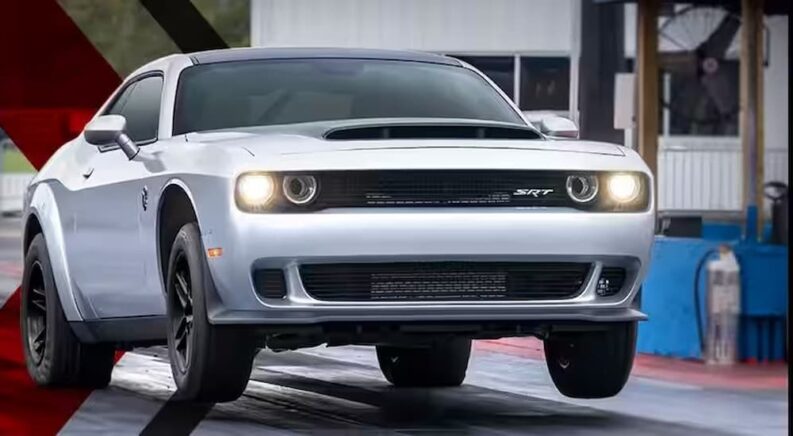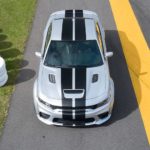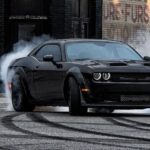After an iconic 57-year run, the Dodge Charger took its final lap at the end of 2023. The Charger carved out quite a following during its time on the market, boldly tweaking an established formula to become one of America’s favorite muscle cars. After a brief hiatus between 1987 and 2006, the Charger was reintroduced as a four-door model, serving as a larger alternative to the traditional, two-door Dodge Challenger. The new Charger represented a more practical option for those looking to enjoy the high-speed thrills of the muscle car segment without sacrificing the space and convenience of a four-door sedan.
Step into any used Dodge dealership, and you’ll notice that the Charger follows a well-worn path as it rides off into the sunset. Tightening emissions standards saw the two-door Dodge Challenger discontinued at the end of 2023, and Chevy’s own muscle car offering will join the pair at the end of 2024 as the Camaro meets its maker. The end of the modern muscle car era is enough to make any driver nostalgic, which is why we’ve compiled a short list of some of the most memorable Charger special editions to hit the streets over the muscle car’s five-decade run.
From a Black Ghost and a high-proof dragstrip beast to an ultra-rare creation from automotive Carroll Shelby, join us as we take a trip down memory lane and console ourselves with the wise words of one Dr. Suess: “Don’t cry because it’s over, smile because it happened.”
1987 Shelby Charger GLH-S
The 1987 Shelby Charger GLHS marks a unique moment in Charger history. Storied automotive designer and racer Carroll Shelby might be best known for his work on such iconic models as the Shelby Cobra and famous Ford collaborations like the GT 350 and 500, but the Le Mans legend also lent his services to Chrysler in the 1980s with two special projects: the 1986 Shelby Omni GLHS and 1987 Charger GLHS. Based on the Shelby Charger, which first hit dealerships in 1983, the Charger GLHS (short for “Goes Like Hell S’more) was itself a continuation of the Charger GLH models from earlier in the decade.
Powered by a 175-hp Turbo I engine, the Shelby-designed Charger was souped up with a new intercooler, turbocharger, and Getrag five-speed manual transmission. If that 175 hp seems a little underwhelming by muscle car standards, there’s a simple explanation: the 80s iteration of the Charger wasn’t a muscle car but a subcompact hatchback. It’s a notable departure from the classic model but one that fits within the prevailing automotive culture of the time.
The Dodge Shelby Charger GLHS’s most unique feature might just be its badging. With its decidedly 80s L-body design, the muscle car was technically marked as a Shelby model instead of a Dodge. What’s with the brand confusion? Shelby had purchased 1,000 Dodge Charger Shelby models directly from the manufacturer, shipping them to his Whittier, California-based factory where they were converted into the limited-edition Charger GLHS. In addition to the revised engine, Shelby also outfitted the Charger GLHS with some important suspension upgrades, new Z-rated tires, and Centurion 2 wheels that were crafted in-house. With a top speed of 130 mph and a quarter-mile time of 14.8 seconds, the Shelby Charger GLHS is a prime example of Shelby’s automotive genius at work.
2006 Dodge Charger SRT8 Super Bee
After a nearly 20-year absence, the Charger burst back onto the scene in 2006 as Dodge introduced the model’s sixth generation. The classic ride returned to its muscle car ways — albeit with a new, four-door design — nixing the hatchback approach of the 80s in favor of a more traditional, performance-focused form. Offered in four trims, including the range-topping SRT8 with a 6.1-liter 425-horsepower HEMI V8 that was more powerful than any HEMI engine to date, the sixth-gen Charger allowed Dodge to reclaim its rightful place in the muscle car power ranking.
Those looking for an even more exclusive version of the revived Charger had two special edition models to choose from: the 2006 Charger Daytona R/T (limited to 6,000 units) and the ultra-rare Dodge Charger SRT8 Super Bee (just 1,000 units). An homage to the Dodge Super Bee muscle car produced between 1968 and 1970; the Dodge Charger SRT8 Super Bee was built on the SRT8’s impressive equipment with a striking Detonator Yellow color scheme with black decals.
Brembo brakes with painted calipers, front sport bucket seats, leather-trimmed seating, 20-inch tires, forged aluminum alloy wheels, and a front grille with black honeycomb inserts set the Dodge Charger SRT8 Super Bee apart from the pack, as did a premium sound system that included a trunk-mounted subwoofer and 13-speaker Kicker audio setup. The Dodge Charger SRT8 Super Bee might not be the most powerful of the special edition models listed here, but it did its part in bringing a little excitement back to the Charger name after a long absence.
2019 Dodge Charger SRT Hellcat Redeye
To appreciate the marvel of automotive achievement that is the 2021 Dodge Charger SRT Hellcat Redeye, we first need to travel back to 2015 when the first Charger Hellcat was introduced. With a supercharged, 6.2-liter HEMI V8 churning out 707 hp and 650 lb-ft of torque, the Hellcat was unlike any Charger to come before. Named after the legendary Hellcat V8, the muscle car certainly didn’t skip leg day, sprinting from zero to 60 mph in just 3.6 seconds and achieving a quarter-mile time of 11.6 seconds. Best of all, it was relatively affordable, with a $60,000 starting price that allowed a wide range of drivers to enjoy a little high-speed fun.
Dodge would up the ante in 2021, rolling out a new high-performance variant of the Hellcat dubbed the Hellcat Redeye. The automaker overhauled the 6.2-liter HEMI V8 and enlarged the supercharger from 2.4 to 2.7 liters, allowing the Charger SRT Hellcat Redeye to produce some 797 hp along with 707 lb-ft of torque. The wide-body model was also treated to a new cold air intake system, a performance-tuned suspension, and a heavy-duty drivetrain that gave it a 6,500-rpm rev limit, 300 more than the tamer base Hellcat. Dodge’s Hellcat-powered lineup of Charger models has since grown to include the Demon, Jailbreak, Super Stock, and more, but the 2019 Dodge Charger SRT Hellcat Redeye will always be one of our favorites.
2023 Dodge Challenger SRT Hellcat Redeye Widebody Black Ghost
Dodge sent the Charger and Challenger off in style with the release of seven “Last Call” special edition models. From the R/T Shakedown with a unique “Shaker” hood and intake system to the Super Bee with its Plum Crazy colorway and drag strip-ready specs and many more, these limited-edition creations almost look more like one-off passion projects than official production models.
While each version is worth its own write-up, we’re going to focus on two models in particular: the SRT Hellcat Redeye Widebody Black Ghost and the 1,000-plus hp 2023 Dodge Challenger SRT Demon 170. We’ll start with the Black Ghost, which is one of two Last Call models designed to honor a street racing legend who plied their trade behind the wheel of a Charger. Godfrey “GQ” Qualls might have spent his days as a member of the Detroit PD, but his nocturnal persona as the street-racing “Black Ghost” earned him a place in Charger history.
Qualls would tear through the Motor City streets in his 1970 Challenger R/T, which was instantly recognizable for its gator-grain vinyl roof. For 2023, Dodge improved on the original, replacing the original V8 with an 807-hp Hellcat while gracing the Black Ghost with a gator-grain decal, unique badges, and a chrome fuel door.
2023 Dodge Challenger SRT Demon 170
With a blistering zero-to-60-mph time of 1.66 seconds (on a prepared drag surface), the 6.2-liter supercharged V8 Demon 170 is basically just a rocket turned on its side. Don’t believe us? Just wait until you hear the story behind the number 170. While these types of three-digit numbers usually refer to an engine’s displacement, 170 is actually a reference to the E85 fuel needed to achieve the car’s maximum output of 1,025 hp and 940 lb-ft of torque. Boasting an 85 percent ethanol content, this powerful fuel would have to be labeled as 170 proof if it were designed for human consumption.
Dodge has leaned into the joke by shipping every Demo 170 with its own personalized whiskey bar set that includes the owner’s name and vehicle’s VIN, a glass decanter, cocktail glasses, whiskey stones, and more. The most unhinged inclusion would have to be the shot glass, which, for some reason, is designed to rest directly on the Demon-badged engine. Toasting your V8 might sound like a weird way to throw back a shot, but it couldn’t be any stranger than a pickleback.
The Evolution Continues…
While some fear that the departure of the Charger, Challenger, and their contemporaries mark the end of the muscle car era, that could be something of an overstatement. The gas-powered versions of these iconic rides are certainly on their way out, but a new age of electrification holds a lot of potential for the performance-focused segment. We’ve already seen a number of automakers embrace the EV approach to create some of the most exciting sports cars in recent memory, and it’s easy to see Dodge doing the same.
While some might wax nostalgic for the heady smell of gas and the roar of a good old-fashioned V8, EVs are the wave of the future. As the segment continues to evolve, we’re willing to bet that the low cost of ownership, instant torque, and record-setting performance is sure to win over those internal combustion die-hards, but if you’re looking to own a little slice of automotive history, the used market is always full of memorable Charger models to choose from.




